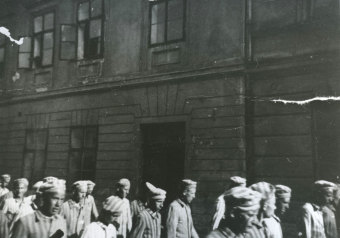The Buna External Work Detachment (April 1941 to July 1942)

© Fritz Bauer Institute (APMO Collection / Auschwitz-Birkenau State Museum)
In mid-April 1941, the Buna external work detachment, under SS guard, marched out for the first time to the plant construction site of I.G. Farben at Auschwitz. On April 21, 1941, the detachment had a prisoner strength of 150 men.
The construction management of I.G. Farben and the SS repeatedly came into conflict over the strict control and supervision of the prisoners at their workplaces on the construction site, as well as during the march between the Auschwitz concentration camp and the place of deployment, a journey of 6 to 7 kilometers (3–4 miles) each way. In the initial period, the prisoners were transported by truck each day; this arrangement was stopped in May 1941, when the Buna detachment had grown to several hundred laborers. The long march robbed the ailing and undernourished inmates of their last reserves of strength and increased the death rate. In the eyes of the plant management, the prisoners’ grueling walk represented a useless physical wastage of manpower, lowered their productivity, and took up many hours of valuable work time. In late July 1941, therefore, I.G. Farben ordered the prisoners to travel on a Reichsbahn train between the main camp and the train station in the village of Dwory
The daily transport of the approximately 1,000 to 2,000 prisoners of the Buna detachment, accompanied by SS guards, in 10 or 12 freight cars was laborious and time-consuming. As of fall 1941, in addition, troup transports for the Wehrmacht were directed onto the already overburdened rail line, frequently causing the trains to the construction site to be delayed by hours. In late December 1941, most of the construction work was interrupted because of heavy frost, and transportation by rail was discontinued. In March 1942, the deployment of prisoners was increased once more, and the Reichsbahn transports were resumed. The management of I.G. Auschwitz called on the commandant’s office for the Auschwitz concentration camp to set up a subcamp for the firm’s use, and it finally opened in October 1942, under the name of Monowitz.
(FS; transl. KL)
















